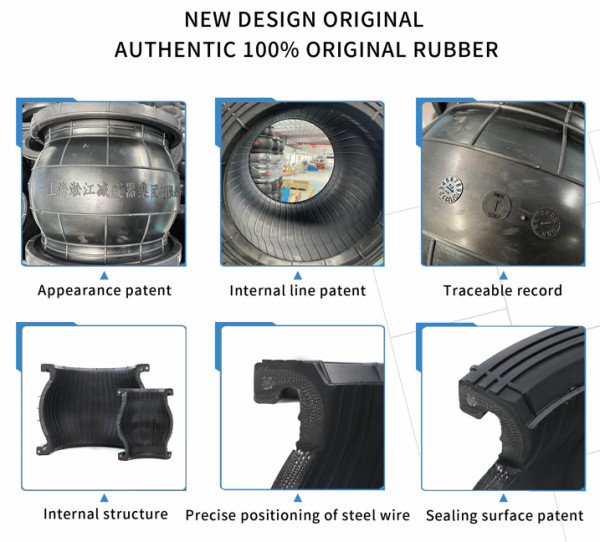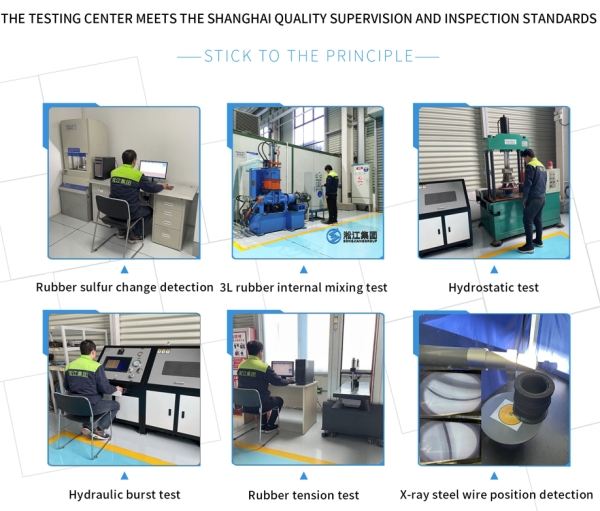DN150 Fluoro Rubber Acid-Resistant Rubber Expansion Joints ‘The Rubber King’
The official website of Shanghai Songjiang Vibration Absorber Group Co., Ltd. introduces information about the ‘2 DN150 Fluoro Rubber Acid-Resistant Rubber Expansion Joints – ‘The Rubber King.” Songjiang Group provides FKM rubber expansion joints for special environmental conditions, primarily using fluoro rubber in production. These joints have acid resistance capabilities, surpassing those of EPDM rubber. While EPDM rubber can only withstand weak acids and strong alkalis at temperatures below 120 degrees Celsius, fluoro rubber can withstand strong acids and temperatures below 140 degrees Celsius, earning it the title of ‘The Rubber King.’
1. Photographs of DN150 Fluoro Rubber Acid-Resistant Rubber Expansion Joints in action:





2. Introduction to DN150 Fluoro Rubber Acid-Resistant Rubber Expansion Joints:
Product Name: FKM Rubber Single Sphere Rubber Expansion Joints
Model: DN150 Installation Length: 180mm Axial Compression: 18mm Axial Extension: 10mm Axial Tension: 10mm Lateral Displacement: 12mm Deflection Angle: 15°
Standard: GB/T 9119-2000
Pressure: PN16 Flange: Carbon Steel / Ductile Iron
Media: Strong Acid, up to 120 degrees Celsius Warranty: 1 year Rubber Material: Fluoro Rubber (FKM)
Advantages: Shock Absorption, Noise Reduction, Protection for Long-Term Pipeline Equipment Use, Reduced Maintenance Costs.
For more details and additional model parameters, please refer to the KXT Flexible Rubber Expansion Joints. Manufacturer: Shanghai Songjiang Vibration Absorber Group Co., Ltd. Certificates: Certificate of Conformity, Warranty Certificate, Inspection Report, TUV Rheinland Germany Certification, National Type Test Report, Third-Party Performance Test Report.
3. The introduction of FKM Rubber Material:
The following information is from Baidu Baike for reference and is not provided by our factory engineers. It describes the properties of pure fluoro rubber. The DN150 Fluoro Rubber Acid-Resistant Rubber Expansion Joints is a hybrid fluoro rubber, and its performance may be slightly lower.
Excellent Stability: Fluoro rubber exhibits excellent chemical stability and is one of the best elastomers in terms of resistance to various media. Type 26 fluoro rubber is resistant to petroleum-based oils, ester-based oils, silicone ethers, silicic acid oils, inorganic acids, most organic and inorganic solvents, and pharmaceuticals. It is only not resistant to low-molecular-weight ketones, ethers, esters, amines, ammonia, hydrofluoric acid, chlorosulfonic acid, and phosphate-based hydraulic oils. Type 23 fluoro rubber exhibits similar properties to type 26 but offers better resistance to strong oxidizing inorganic acids, such as fuming nitric acid, and concentrated sulfuric acid, and exhibits minimal volume expansion (only about 13% to 15%) when immersed in 98% HNO3 at room temperature for 27 days.
High-Temperature Resistance: Fluoro rubber’s high-temperature resistance is comparable to silicone rubber, making it one of the best elastomers in this regard. Type 26-41 fluoro rubber can be used for extended periods at 250°C and briefly at 300°C. Type 246 fluoro rubber has even better heat resistance than type 26-41. Type 26-41 fluoro rubber maintains good properties, including a tensile elongation rate of around 100%, and a hardness of 90-95 degrees, after 300°C × 100 hours of air heat aging. Type 246 fluoro rubber retains excellent elasticity after 16 hours of air aging at 350°C and 110 minutes of air aging at 400°C. If the material contains spray carbon black, thermal cracking carbon black, or carbon fiber, the tensile elongation rate increases by approximately 1/2 to 1/3, and the strength decreases by about 1/2, while still maintaining good elasticity. Type 23-11 fluoro rubber can be used for long periods at 200°C and briefly at 250°C.
Aging Resistance: Fluoro rubber demonstrates excellent resistance to weathering and ozone. DuPont’s VitonA, for example, maintains satisfactory performance even after ten years of natural storage, with no noticeable cracking after 45 days of exposure to air with 0.01% ozone concentration. Type 23 fluoro rubber also exhibits excellent resistance to weathering and ozone.
Vacuum Performance: Type 26 fluoro rubber boasts excellent vacuum performance. The degassing rate of sulfur vulcanized rubber with the basic formulation of type 246 fluoro rubber is only 37 × 10-6 cm3/second·cm2. Type 246 fluoro rubber has been successfully used under conditions as low as 10-9 mbar.
Mechanical Properties: Fluoro rubber exhibits excellent physical and mechanical properties. Type 26 fluoro rubber typically has tensile strength ranging from 10 to 20 MPa, elongation at break between 150% and 350%, and tear strength between 3 and 4 kN/m. Type 23 fluoro rubber exhibits tensile strength ranging from 15.0 to 25 MPa, elongation at break between 200% and 600%, and tear strength between 2 and 7 MPa.
Electrical Properties: Type 23 fluoro rubber demonstrates good electrical properties and lower moisture absorption compared to other elastomers, making it suitable as an electrical insulating material. Type 26 rubber can be used at low frequencies and low voltages.
Low Temperature Performance: Fluoro rubber does not perform well at low temperatures due to its chemical structure. For example, the Tg of type 23-11 fluoro rubber is above 0°C. The low-temperature performance of fluoro rubber is typically indicated by its brittle temperature and compression set coefficient. The formulation of the material and the product’s shape, such as thickness, have a significant impact on the brittle temperature. Increased filler content in the formulation can make the brittle temperature more sensitive. Increased product thickness can also negatively affect low-temperature performance.
Radiation Resistance: Fluoro rubber has relatively poor resistance to radiation compared to other elastomers. Type 26 rubber exhibits cross-linking effects after radiation exposure, while type 23 fluoro rubber exhibits degradation effects. Type 246 fluoro rubber shows a significant change in properties after exposure to 5 × 107 rad at room temperature in air. Under conditions of 1 × 107 rad, its hardness increases by 1-3 degrees, tensile strength decreases by less than 20%, and elongation decreases by 30-50%. Therefore, it is generally considered that type 246 fluoro rubber can withstand up to 1 × 107 rad, with a limit of 5 × 107 rad
4. Factory Introduction for DN150 Fluoro Rubber Acid-Resistant Rubber Expansion Joints:





In addition to fluororubber being able to withstand strong acids, there is also a type of PTFE-lined fluororubber joint that can withstand strong acids and alkalis. The performance of PTFE-lined fluororubber in resisting strong acids and alkalis is even better than that of fluororubber. The price is similar to that of fluororubber. For more information, please click: PTFE Lined Polytetrafluoroethylene Rubber Joint







![[Lubrizol Speciality Chemicals Shanghai Project] Metal Hose Contract](https://www.sungkiangflex.com/wp-content/themes/sj-1/timthumb.php?src=https://www.sungkiangflex.com/wp-content/uploads/2024/06/Lubrizol-Speciality-Chemicals-Shanghai-Project-Metal-Hose-Contract-1.jpg&h=300&w=400&zc=1)


